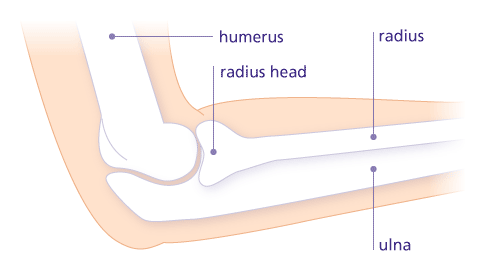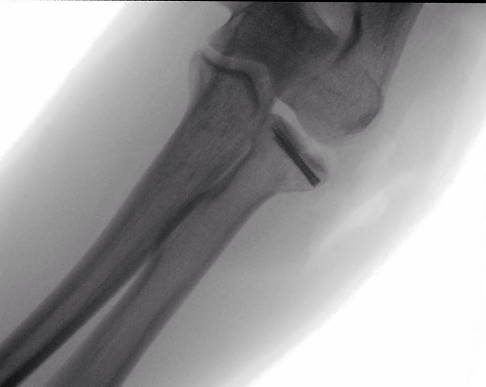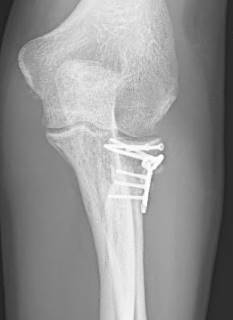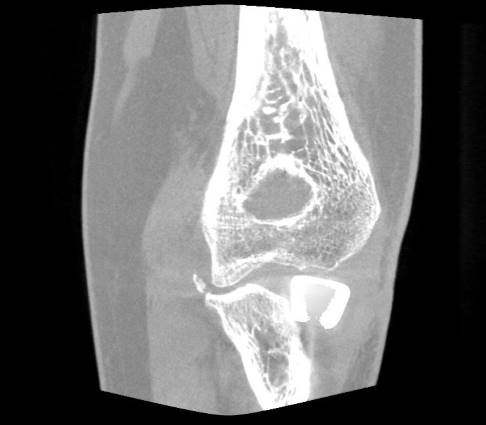Radial head fracture: poor healing could mean elbow arthrosis and stiffening
- Causes: Why does the radial head break?
- What are the symptoms of a radial head fracture?
- What are possible late complications of a radial head fracture?
- Treatment: How does the elbow specialist treat a radial head fracture?
 The complex elbow joint is made up of three bones: The humerus is connected to the ulna and radial head of the forearm. The three bones are surrounded by a common joint capsule. © Gelenk-Klinik
The complex elbow joint is made up of three bones: The humerus is connected to the ulna and radial head of the forearm. The three bones are surrounded by a common joint capsule. © Gelenk-Klinik
A radial head fracture is a fracture in the section of the radius near the elbow. This injury is the most common elbow joint fracture in adults.
The fracture is caused by falling onto the hand with the arm straight or slightly bent. The radial head fracture is seldom caused by falling onto or hitting the elbow directly.
The radial head fracture can cause
- simple fractures,
- displaced fractures, or
- comminuted fractures, or
- malunion radial head fractures.
In the case of complex fractures, the orthopaedist can expect capsule or ligament injuries. This in turn significantly impacts aftercare and healing.
Typical symptoms of a radial head fracture are elbow pain and swelling on the outside. In addition, elbow movement is often limited.
The radial head is an important part of the elbow joint. The radial head rotating around its longitudinal axis allows us to turn the forearm inward and outward.
Poorly healed radial head fractures: Risk of chronic pain
Treatment must account for the type of fracture and the concomitant ligament injury to avoid complications and late complications due to poor healing. Poorly healed fractures can result in permanent restriction of movement and instabilities in the elbow. A stiff elbow, early joint wear (arthrosis of the elbow) or even osteonecrosis (radial head necrosis) are possible consequences.
A radial head fracture should therefore always be treated by an elbow specialist to prevent grave secondary failures. The elbow specialist at Gelenk-Klinik will gladly see you and would be happy to help you.
Causes of the radial head fracture: Why does the radial head break?
 Typical accident with radial head fracture: Falling onto the hand with the arm straight or slightly bent. © Halfpoint, Adobe Stock
Typical accident with radial head fracture: Falling onto the hand with the arm straight or slightly bent. © Halfpoint, Adobe Stock
The most common accident mechanism of a radial head fracture is falling onto the straightened or slightly bent arm when the person tries to brace themselves with their hand during a fall. The forearm is turned inward in the process.
This causes sudden, massive forces through the hand and the extended arm onto the elbow joint. In the process, the radial head collides with the solid end of the humerus and breaks. The fracture is caused by indirect forces in this case.
The straighter the elbow joint is during the fall, the more likely a radial head fracture. The fracture is seen in all age groups, however the average age is about 40 years. Men and women are affected equally. Particularly individuals involved in sports experience a radial head fracture.
What are the symptoms of a radial head fracture?
- Pressure pain in the respective radial head
- Pain on the outside of the elbow radiating to the hand
- Redness, swelling and bruising of the elbow
- Painful, limited movement in the elbow joint, particularly when turning and extending the forearm
 Typical symptoms of a radial head fracture are pain and swelling on the outside of the elbow. Turning the forearm inward and outward is painful and limited, and the individual is often unable to fully bend and straighten the joint. © Sentello, Adobe Stock
Typical symptoms of a radial head fracture are pain and swelling on the outside of the elbow. Turning the forearm inward and outward is painful and limited, and the individual is often unable to fully bend and straighten the joint. © Sentello, Adobe Stock
Pressing on the respective radial head causes severe local pain. Turning the forearm inward and outward as well as extending and bending the elbow is very painful. If the fracture is accompanied by swelling with bruising around the elbow, this can be a sign of capsule or ligament injuries.
The fracture often causes blood to seep into the joint, which further limits mobility in the elbow. If the fractured radial head is displaced (dislocation), joint mobility can even be completely blocked. Likewise, the fall can also damage the other two bones in the joint (humerus and ulna).
While nerve damage is rare, even in serious injuries. If the radial nerve is injured, paraesthesia will appear in the hand. In addition, hand function may be impaired.
Injuries associated with a radial head fracture
About every third of the patients with a radial head fracture will also have injuries to the ligaments or bone structure.
- The most common injury is to the lateral collateral ligament, which supports the joint capsule of the elbow.
- Other collateral ligaments, the annular ligament and the joint capsule may be injured.
- The solid fibrous capsule connecting the ulna and radius along the entire length may also be torn.
- The carpal bones may also break during the fall.
Radial head fracture is not just a bone injury. There often are associated injuries, which must be taken into account during the initial diagnosis and further treatment.
How can the radial head break?
Radial head fracture is classified according to the Mason classification as four types of fractures. The classification takes into account the number of fracture fragments and their displacement (dislocation). These criteria help the physician determine how serious the injury is.
What are possible late complications of a radial head fracture?
Delayed treatment or less than ideal treatment of a radial head fracture bears the risk of late complications, which will greatly impact the patient's daily living and quality of life.
Late complications of a radial head fracture:
- Limited movement: The radial head is particularly important in supination and pronation of the forearm. Malunion fractures will cause steps in the joint and therefore prevent proper joint mobility. Bone or cartilage fragments can become trapped in the joint space and thus completely block inward and outward rotation of the forearm.
- Frozen elbow: Growths and scarring from healing and thickening of the joint capsule impair elbow function. Even immobilising the joint in a flexed position for some time with a cast or after surgery are risk factors for an extension deficit.
- Chronic instability of the elbow joint: Suboptimal healing of ligaments and tendons result in joint instability. Some chronic epicondylitis (tennis elbow) is caused by ligament instability due to past injuries.
- Arthrosis of the elbow: Malunion fractures of the radial head result in increased cartilage wear in the elbow joint. This results in early joint wear (arthrosis), often only years after a fracture.
- Radial head dying off due to blood flow disorders: Comminuted fractures in particular can damage the blood vessels supplying the bone and the bone dies off (radial head necrosis).
- Damage due to undetected associated injuries: Damage to the humerus and the ulna or a fractured wrist often remain undetected.
Treatment: How do elbow specialists treat a radial head fracture?
Our many years of experience in treating these injuries ensure treatment specific to your needs. In the process we take the patient's specific needs for arm function as well as the underlying injury pattern including any associated injuries, thus the expected prognosis of conservative treatment or surgery into account. The elbow specialists at Gelenk-Klinik offer optimal advice in planning the treatment.
Radial head fracture surgery
Comminuted fractures, displaced or malunion fractures require surgery. The extent of the procedure will be aligned with the extent of the fracture or displacement. An orthopaedist can also realign malunion fractures into their natural position through surgery.
1. Radial head reconstruction with screws and plates
 The radial head fracture was treated with screws and plates (osteosynthesis). © Gelenk-Klinik
The radial head fracture was treated with screws and plates (osteosynthesis). © Gelenk-Klinik
A fracture with displaced fragments by more than 2 mm (type 2 fracture according to Mason) is typically treated with small screws or plates. This procedure is referred to as osteosynthesis and can be performed as minimally invasive surgery.
The displaced bone fragment is realigned in its original position and fixed. This prevents steps in the articular surface. Screws or plates do not necessarily need to be removed later. Associated ligament injuries can also be addressed during surgery.
2. Radial head reconstruction using fixed angle plates
 Combined screw osteosynthesis with a fixed angle plate in a patient with comminuted fracture of the radial head (Mason 3) after falling off a mountain bike. The x-ray already shows the healed situation. © Gelenk-Klinik
Combined screw osteosynthesis with a fixed angle plate in a patient with comminuted fracture of the radial head (Mason 3) after falling off a mountain bike. The x-ray already shows the healed situation. © Gelenk-Klinik
Complex fractures with several fragments and concomitant luxation can also be treated with osteosynthesis to save the head. In this case, special fixed-angle radial head plates are used to fix the individual fragments in place.
3. Irreparable radial head fracture: Use of a radial head prosthesis
 Overstuffing of a radial head prosthesis implanted at another clinic: The radius bone is longer than before with the prosthesis implanted. © Gelenk-Klinik
Overstuffing of a radial head prosthesis implanted at another clinic: The radius bone is longer than before with the prosthesis implanted. © Gelenk-Klinik
If the radial head has shattered into several small fragments, reconstruction is not an option. In this case, a radial head prosthesis should be considered.
Implanting a radial head prosthesis is challenging. The diameter of the prosthesis should match the native radial head and the prosthesis must not protrude too far beyond the joint area at the ulna. This is referred to as “overstuffing” and must be avoided at all cost. This is essential to prevent pain with limited motion and increased cartilage wear in the elbow joint.
If the ligaments on the inside are stable, the radial head can also be removed without implanting a prosthesis. The body will then form a cartilaginous, scarred replacement at the radial neck. This radius resection is rather the exception.




